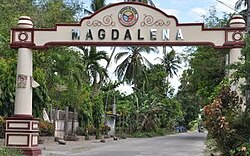Magdalena, Laguna
| Magdalena | ||
|---|---|---|
| Municipality | ||
 |
||
|
||
|
Nickname(s): Little Hollywood of Laguna The Bamboo Capital of Laguna |
||
 Map of Laguna showing the location of Magdalena |
||
| Location within the Philippines | ||
| Coordinates: 14°12′N 121°26′E / 14.2°N 121.43°ECoordinates: 14°12′N 121°26′E / 14.2°N 121.43°E | ||
| Country | Philippines | |
| Region | CALABARZON (Region IV-A) | |
| Province | Laguna | |
| District | 4th district of Laguna | |
| Founded | January 18, 1820 | |
| Barangays | 24 | |
| Government | ||
| • Mayor | David Aventurado Jr. | |
| • Vice Mayor | Constancio Burbos | |
| • Councilors |
List of councilors
|
|
| Area | ||
| • Total | 34.88 km2 (13.47 sq mi) | |
| Population (2015 census) | ||
| • Total | 25,266 | |
| • Density | 720/km2 (1,900/sq mi) | |
| Time zone | PST (UTC+8) | |
| ZIP code | 4007 | |
| IDD : area code | +63 (0)49 | |
| Income class | 4th | |
Nickname(s): Little Hollywood of Laguna
Magdalena is a fourth class municipality in the province of Laguna, Philippines. According to the 2015 census, it has a population of 25,266 people.
Magdalena is politically subdivided into 24 barangays.
Magdalena was formerly a barrio of Majayjay, Laguna. A petition from the residents of the barrio for the creation of a new town was presented on September 15, 1819. It was proclaimed a new town by Governor General Don Mariano Fernández de Folgueras on January 18, 1820, and was originally named "Magdalena de Ambling". The name was derived from its patron saint Maria Magdalena and the barrio of Ambling where it was established. The first Teniente Alcalde or Capitan (the highest political authority in a town) was Don Mauricio San Mateo.
They first established a makeshift school in 1820, which was the very first requirement for it to be a town. The municipal hall was also constructed. A small chapel was also constructed and it gave way to the construction of a church in 1829. The church was made of stones and bricks and donations were solicited from the residents. The construction was finished in 1861. The construction of the concrete town hall and the church convent started in 1871, and was finished in 1884.
The revolt against the Spaniards in this area started on November 13, 1896, when the male residents joined the revolutionaries from the province to form a bigger force. It was during one of the encounters that Emilio Jacinto was wounded and sought refuge at the Catholic Church.
Emilio Aguinaldo, then, proclaimed the first Philippine Republic and the Spaniards finally surrendered on September 1, 1898, and celebrations followed.
The arrival of the Americans, at the turn of the century, witnessed the evacuation of the townsfolk to the mountains for fear of being killed, later returned to the Poblacion seeing that the foreigners were well-intentioned.
The Americans enforced a new system of government. Election of government officials was conducted regularly. The first elected President Municipal was Don Victor Crisostomo. It was during this time that rebels, called tulisan, formed a force to oppose the foreign rule. They robbed the house of the residents. This made the Americans very strict on social life of the people, prohibiting them from leaving the Poblacion and talking to each other publicly. It was on June 15, 1929 that electricity was introduced in the municipality. Life continued under the American regime and to an extent, introduced their own culture to the Filipinos until the Second World War broke out in 1941.
...
Wikipedia


